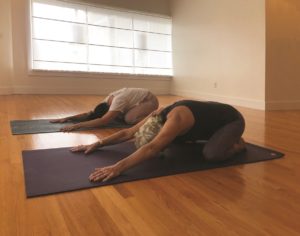You’re going to hear a lot about breast cancer in this “awareness” month. The good news on this subject is that research is beginning to emerge supporting what has always seemed to me to be true: physical activity can decrease treatment side effects, increase ability to tolerate treatment, and reduce the anxiety that comes with a serious diagnosis.
What is it really like, though, to keep your body moving when you’re going through breast cancer treatment? The answer is surely different for everyone. But for Karen Nordahl and Justine Rice, Wellfleet friends who talked with me about their experiences, one of the main lessons has been to adapt and to have patience, because recovery takes time.
When Karen was diagnosed with breast cancer in December 2020, she knew that keeping her body moving would be an important part of getting through it. She had always been active — she walked, did yoga and Pilates, and worked long hours at her restaurant job.
But even though exercise was a priority, it wasn’t always easy or even possible to do. Her treatment included surgery, chemotherapy, and radiation. The first round of chemo hit her hard, she says. She felt nausea and a lack of energy.
“There were days when I could barely get off the couch,” she says. “My friend would come over to walk the dog for me.”
As she adjusted to the treatment regimen, she also had to reset her expectations. She would have three good days, then be down for five. On the good days, she would take her dog for a short walk around the neighborhood. Later, the radiation schedule was grueling: five days a week for six weeks, she’d travel to Hyannis, go home to Wellfleet for lunch, and then go off to work.
Karen could have taken some time off from work, but she made the decision that some of her energy would go there. “I wanted to keep my brain moving, too,” she says. At the restaurant, she’d always been a hands-on manager, but now she found herself directing the action and not doing much of the physical work. She is grateful that her boss and coworkers were supportive.
By July, the treatments were over, but she was left with a profound fatigue as well as a tight shoulder. After surgery and radiation, scar tissue tends to contract, which limits motion in the chest and shoulder. Karen worked with a physical therapist who did massage and lymphatic drainage, which really helped to get the arm moving. She did a bit of yoga and kept walking the dog, but she still felt weak.
After such an intense experience, it makes sense that both body and mind need time to recover. “I was surprised how much the treatment had affected my whole body and thought process,” Karen says. It was hard to imagine going back to her old Pilates routine. She took the step, though, of reaching out to Petra Ledkovsky van Aarem, who had been her instructor for years.

Karen wasn’t ready to pick up where she had left off, but Petra helped her realize that she didn’t have to. Petra made modifications that helped her to begin gently and progress gradually through the winter. This summer, Karen says, her walks started getting longer, and she could do more of the heavy lifting at work. Now, more than a year after finishing treatment, she can tell she’s getting stronger. “I feel like I’m getting myself back,” she says.
What would she tell someone about keeping moving during treatment? “Just listen to your body and take it one day at a time,” Karen says.
Justine Rice worked out a lot, always pushing herself to the next level, running hard and lifting heavy. When she got a breast cancer diagnosis in June 2021, she kept training until her mastectomy in September. Surgery brought huge changes, though, as she was unable to lift anything over five pounds for six weeks.
She was able to take short walks, which she soon embraced. “The daily woods and beach walks were a source of healing with other activities so limited,” she says. Day by day, she could walk farther and make small gains. She shifted her focus from fitness to mobility.
Justine had all her treatments at Dana Farber Cancer Institute in Boston: the surgery, 30 rounds of radiation, and immunotherapy infusions.
For Christmas, a friend gave her a gift certificate to a local yoga studio. Being new to the practice “was daunting,” she says, “but it turned out to be my saving grace.”
Instructor Susannah van der Wende was a good match for her: as a former competitive athlete, she knew where Justine was coming from. Susannah guided her to poses that would eventually open up her chest and shoulders. Justine also found benefits beyond the physical. “Mindfulness and breathing together with movement really helped me through,” she says. She practiced yoga and walked her dogs nearly every day leading up to her reconstruction surgery in May.
This second surgery left her very limited again. Even yoga was out of reach for a while. But she realized she could still do the breathing techniques and practice mindfulness from yoga. She kept moving, though gently, continuing her daily walks. Now, Justine is back to a regular yoga practice, household activities, and running a landscape business with her husband.
Justine adds to Karen’s encouragement to listen to your body as you keep moving, and the reminder that recovery takes time. She says what she learned through all of this was “there is hope and possibility in every diagnosis.”



